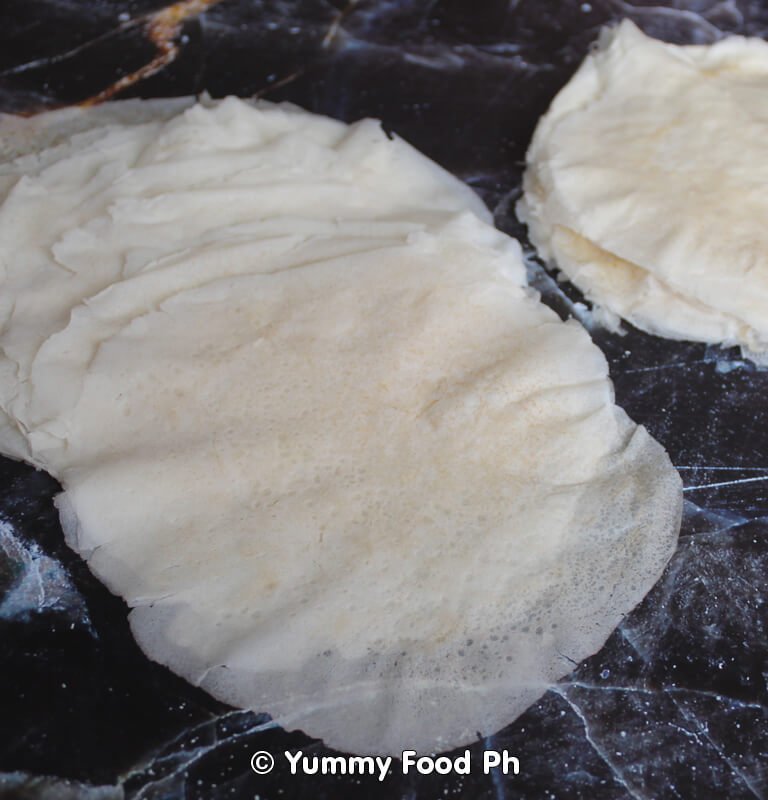Spring roll wrapper, also known as LUMPIA wrapper in the Philippines, are thin paper-like skins.
Introduction
Spring roll wrappers, known as lumpia wrappers in the Philippines, represent one of the most ingenious innovations in Asian culinary technology. These translucent sheets – thinner than parchment yet stronger than tissue – serve as edible packaging for countless flavor combinations. Originating from Chinese wheat-based wrappers and evolving through Southeast Asian adaptations, these delicate skins bridge the gap between crisp texture and flexible strength, offering endless creative possibilities for both professional chefs and home cooks.
They are delicate and light in texture but robust enough to wrap around and retain your fillings without breaking. Spring roll wrappers that is similar to “crepes”. Speaking of crêpes or crepe, are you familiar with them? It is a very thin type of pancake that originated in Brittany and is also made of flour. Spring roll wrappers are made with four simple ingredients. The following main ingredients are flour, cornstarch, salt, and water. These components are mixed together to make a very moist and thick dough that is stronger and more elastic, making it more durable in retaining many sorts of fillings like vegetables, chicken, pork, beef, and much more. If you prefer preparing crispy spring rolls from home, you’ll need an excellent spring roll wrapper (Lumpia Wrapper).
Spring rolls are gaining more popularity because of their crispness when cooked. They are filled with minced or ground stuffing and can be pork, vegetables, fish, poultry, beef and much more. A food wrapper called a spring roll wappper ( lumpia wrapper) is made of dough or rice paper that is rolled after being folded before being deep fried, steamed or even baked. They can also be served fresh, with a ready-to-eat wrapper that has been filled with fillings. The ingredients to make fresh and dry wrappers are common but vary in process. You want to cook spring rolls? Check out our spring roll recipes. It’s so easy and yummy. Feel free to browse our recipe archive.
These ingredients are frequently used in culinary preparations.
Spring Roll Wrappers: The Delicate Art of Asian Wrap Craft
Manufacturing & Composition
- Traditional Production:
- Wheat flour/rice flour batter
- Water-thin spreading on hot griddles
- Instant drying into pliable sheets
- Modern Variants:
- Egg-added versions for elasticity
- Tapioca-blended for gluten-free options
- Pre-fried “crispy” versions
Physical Properties
- Thickness: 0.1-0.3mm (comparable to writing paper)
- Diameter: 15-25cm standard rounds
- Texture:
- Dry state: Brittle and crackly
- Hydrated: Becomes stretchable
- Fried: Turns glass-crisp
Culinary Applications
Preparation Techniques:
- Hydration Method:
- Damp cloth wrapping
- Brief water dipping
- Steam reactivation
- Folding Styles:
- Chinese envelope fold
- Filipino cylinder roll
- Vietnamese open-end wrap
Global Variations:
- Philippines: Lumpiang sariwa (fresh rolls)
- Vietnam: Gỏi cuốn (rice paper alternative)
- China: Chūnjuǎn (wheat-based fry)
- Thailand: Poh pia tod (crispy version)
Storage & Handling
- Refrigeration: 2 weeks in airtight packaging
- Freezing: 6+ months with parchment separators
- Revival: Room temperature tempering
Professional Tips
- Sealing: Cornstarch slurry as “edible glue”
- Frying: 350°F oil for bubble-free crispness
- Prevention: Keep covered during prep to avoid drying
Cultural Significance
- Festival Food: Chinese New Year symbol
- Street Food Staple: Southeast Asian markets
- Fusion Potential: Sushi-spring roll hybrids
Nutritional Profile
- Calories: ~50 per wrapper
- Carbs: 10-12g (primarily complex)
- Protein: 1-2g (wheat versions)
- Fat: 0g (pre-frying)
Conclusion
From Manila’s lumpiang hubad to Shanghai’s fried spring rolls, these remarkable edible wrappers demonstrate how simple ingredients can become extraordinary culinary vehicles. Their unique combination of fragility and resilience mirrors the balance sought in all great cooking – delicate enough to showcase fillings, yet strong enough to contain bold flavors. As global cuisine continues to evolve, the spring roll wrapper stands ready to embrace both tradition and innovation in every transparent fold.
Visit us on YouTube: Yummy Food PH

